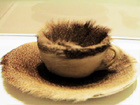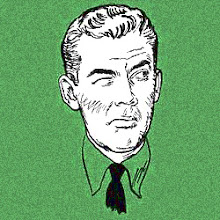 For the August 6 issue of the New Yorker the mag sent out one of its "Talk of the Town" writers to find out what was making Greenwich Village coffeehouse so attractive to "beatniks" - and whether there was much variation between and among the day's bohemians. The first impression the Village gave off incited a list: "motorcycles, sports cars, Cadillacs, Larks, bicycles, tricycles, little kids, bigger kids, boy gangs, man gangs, girl gangs, young couples, old couples, middle-aged couples, loners, black-garbed Italian ladies in their seventies, panhandlers, book carriers, and Beats of various shapes, sizes and natures. Paperback books, handwrought jewelry, antiques, sandals, pottery, straw objects, paintings, simmering Italian sausages, onions, and pizzas, and freshly boiled sweet corn...."
For the August 6 issue of the New Yorker the mag sent out one of its "Talk of the Town" writers to find out what was making Greenwich Village coffeehouse so attractive to "beatniks" - and whether there was much variation between and among the day's bohemians. The first impression the Village gave off incited a list: "motorcycles, sports cars, Cadillacs, Larks, bicycles, tricycles, little kids, bigger kids, boy gangs, man gangs, girl gangs, young couples, old couples, middle-aged couples, loners, black-garbed Italian ladies in their seventies, panhandlers, book carriers, and Beats of various shapes, sizes and natures. Paperback books, handwrought jewelry, antiques, sandals, pottery, straw objects, paintings, simmering Italian sausages, onions, and pizzas, and freshly boiled sweet corn...." Using the "Talk" first-person plural, a coffeehouse denizen is approached:
"You Beat?" we asked.
"It's a legitimate thing to be a Beatnik, even though most of the time it's the provincial thing," he said. "It draws me. It's the power of innocence."
The destination was Cafe Figaro at the corner of Bleecker and Macdougal. Tom Ziegler owned the Figaro and said, "Our Beatniks are the real, true old-fashioned, wonderful bohemians...We don't permit weekend tourst Beatniks--a lot of them come down from the Bronx sporting day-old beards--or any would-be Beatniks who read about the press-created-image Beatniks and try to be like them, to work out their psychic difficulties here."
It was not clear how Ziegler didn't "permit" fake or superficial or part-time beatniks from his establishment. I'm having fun imagining this - and the faux beatniks' reaction to being called out as such.
"Life Line," New Yorker, Aug 6, 1960, pp. 21-23






 Is '60 the moment when the end of the end of the Old Left had been reached and the New Left began to emerge? Is it the final ascendancy, in certain scenes at least, of poetic postmodernity? Surely the publication of Donald Allen's The New American Poetry that year suggests this, but then again--once again--we look back on "New" here and see continuity. The rhetoric of the Kennedy-Nixon contest made much less of a dent than everyone (at the time as well as since) claimed, so one wonders why were such great claims made?
Is '60 the moment when the end of the end of the Old Left had been reached and the New Left began to emerge? Is it the final ascendancy, in certain scenes at least, of poetic postmodernity? Surely the publication of Donald Allen's The New American Poetry that year suggests this, but then again--once again--we look back on "New" here and see continuity. The rhetoric of the Kennedy-Nixon contest made much less of a dent than everyone (at the time as well as since) claimed, so one wonders why were such great claims made?  Had we come to expect "1960" to be truly ubiquitously modern in a way that the 1950s really were not--not quite? And what specifically does "modern" mean in the Kennedyesque talk then and now about the torch being passed to a new generation, etc.? The First Lady really meant "modernist" when Camelotians said "modern." What about the others across the new young cultural leadership? I've been surprised by how frequently the
Had we come to expect "1960" to be truly ubiquitously modern in a way that the 1950s really were not--not quite? And what specifically does "modern" mean in the Kennedyesque talk then and now about the torch being passed to a new generation, etc.? The First Lady really meant "modernist" when Camelotians said "modern." What about the others across the new young cultural leadership? I've been surprised by how frequently the  "Beat movement" was covered in 1960 in the mainstream press. I was expecting a fair measure but I've found tonnage. 1960 was the year when the figure of the beat was beginning to find acceptance, although still 80% of these stories are mocking, rebels-without-cause condescension. For anyone whose analysis made an impact nationally, do these antipolitical adolescents count as part of the "new young cultural leadership"? No, but rather than the two being opposites, they fall along a Continuum of the New American. Now that's a change for '60.
"Beat movement" was covered in 1960 in the mainstream press. I was expecting a fair measure but I've found tonnage. 1960 was the year when the figure of the beat was beginning to find acceptance, although still 80% of these stories are mocking, rebels-without-cause condescension. For anyone whose analysis made an impact nationally, do these antipolitical adolescents count as part of the "new young cultural leadership"? No, but rather than the two being opposites, they fall along a Continuum of the New American. Now that's a change for '60.







